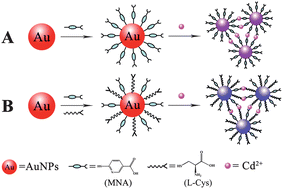Colorimetric detection of Cd2+ using gold nanoparticles cofunctionalized with 6-mercaptonicotinic acid and l-Cysteine†
Abstract
We have developed a colorimetric assay for the highly sensitive and selective detection of Cd2+ using

* Corresponding authors
a
College of Chemistry and Chemical Engineering, Graduate University of Chinese Academy of Sciences, 19A YuQuan Road, Beijing, China
E-mail:
hongzhao@gucas.ac.cn, heyujian@gucas.ac.cn
Fax: +86-10-88256092
We have developed a colorimetric assay for the highly sensitive and selective detection of Cd2+ using

 Please wait while we load your content...
Something went wrong. Try again?
Please wait while we load your content...
Something went wrong. Try again?
Y. Xue, H. Zhao, Z. Wu, X. Li, Y. He and Z. Yuan, Analyst, 2011, 136, 3725 DOI: 10.1039/C1AN15238F
To request permission to reproduce material from this article, please go to the Copyright Clearance Center request page.
If you are an author contributing to an RSC publication, you do not need to request permission provided correct acknowledgement is given.
If you are the author of this article, you do not need to request permission to reproduce figures and diagrams provided correct acknowledgement is given. If you want to reproduce the whole article in a third-party publication (excluding your thesis/dissertation for which permission is not required) please go to the Copyright Clearance Center request page.
Read more about how to correctly acknowledge RSC content.
 Fetching data from CrossRef.
Fetching data from CrossRef.
This may take some time to load.
Loading related content
